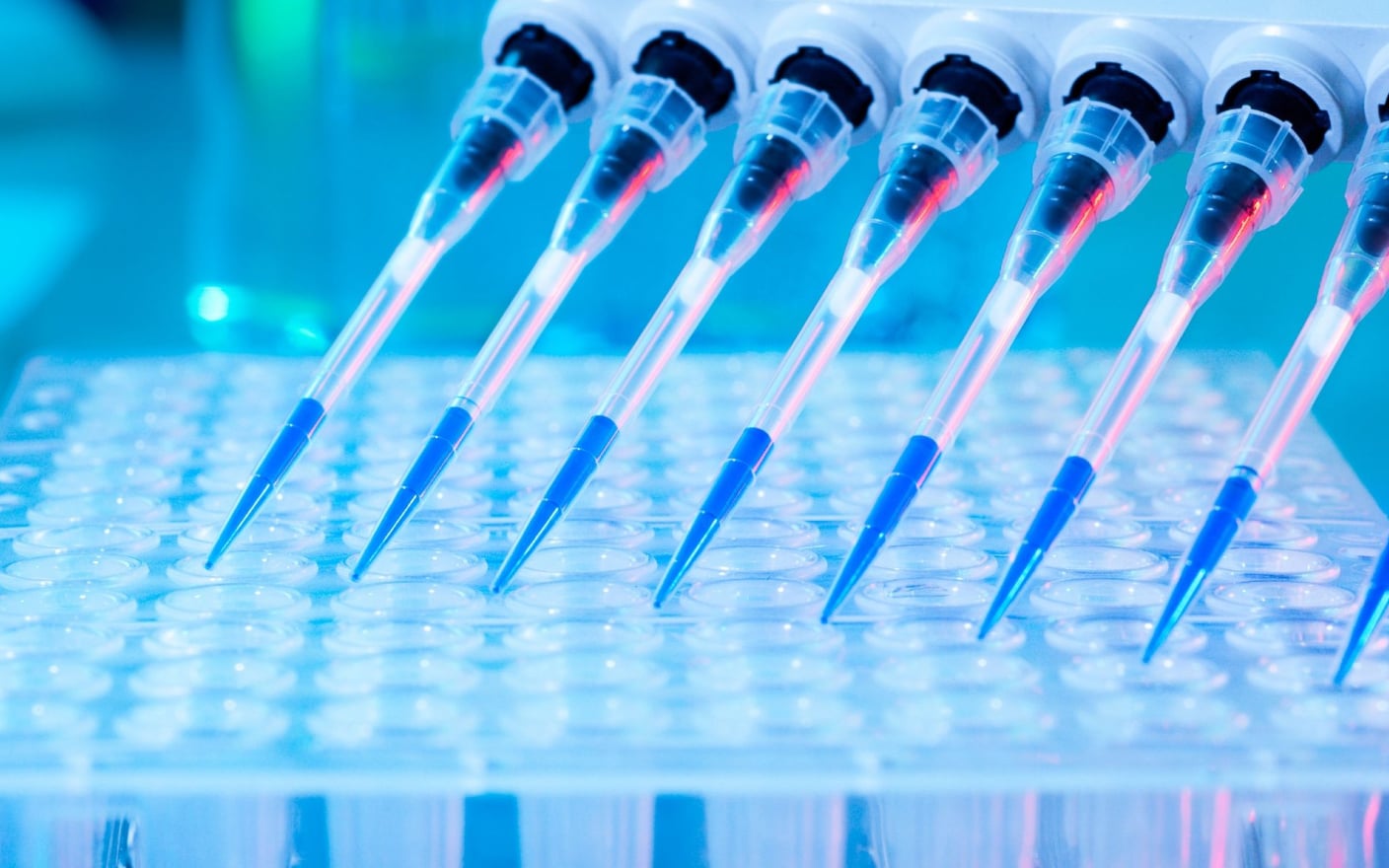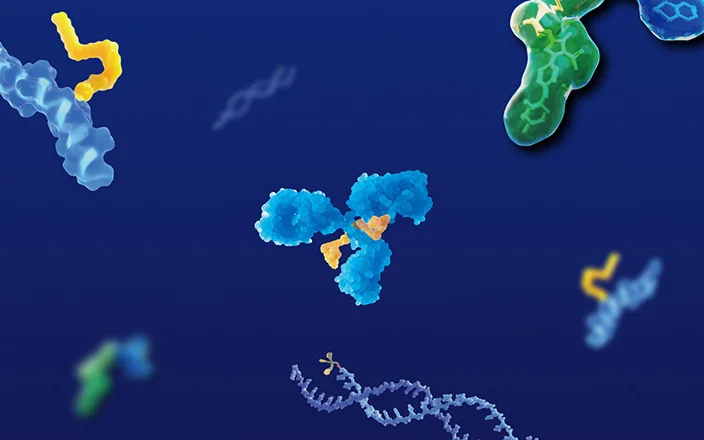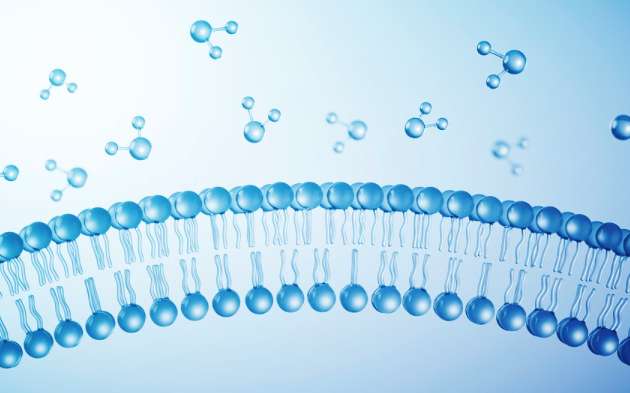Oligonucleotides have been a promising new therapeutic modality in drug discovery projects in recent years. These short DNA or RNA molecules are designed to regulate gene expression and provide targeted therapy for various diseases. There are a lot of uncertainties in the preclinical development of oligonucleotides, such as whether investigators need to carry out relevant research similar to small molecule drugs and include them in regulatory filing packages, and how to carry out corresponding studies since the regulatory authorities have not yet issued formal research guidelines in DMPK studies for oligonucleotides. In this article, the implications, methods, and strategy of protein binding of antisense oligonucleotide (ASO) and small interfering RNA (siRNA) are briefly discussed.
Effect of protein binding on the PK/PD of small molecule drugs
Plasma protein binding (PPB) refers to the degree of drug binding to proteins in blood or plasma. In pharmacology, the drug exists in two forms: free (or unbound) drug and bound drug. Only the unbound drug can diffuse across the cell membranes, reach their sites of action, and be eliminated. In contrast, most of the drug bound to plasma proteins remains within the vascular lumen, providing a reservoir of retained drugs, which are released into circulation as the free drug concentration declines1.
The balance between bound and unbound drugs is of great importance in small molecule drug research and development, which is closely related to the widely accepted "Free Drug Hypothesis". The hypothesis consists of two parts: (i) The free drug concentration at the site of action is the main factor driving the pharmacological action. (ii) At steady state, free drug concentrations on both sides of any biological membrane are the same for drugs that are not substrates of uptake or efflux transporters2, 3. The second part is notably important for understanding the PK/PD of small molecule drugs, particularly those targeting intracellular targets. Therefore, PPB is a key parameter routinely measured in small molecule drug development to establish PK/PD relationships, scale across species, and estimate therapeutic index.
Effect of protein binding on PK/PD of ASOs
The binding of ASOs to plasma proteins can affect their performance in many aspects, including tissue distribution, cellular uptake, intracellular transport, efficacy, and toxicity4. Plasma protein binding of ASOs can significantly affect their systemic clearance, especially renal clearance5. Binding to cell surface proteins can modulate the cellular uptake capacity of ASOs. On the other hand, binding to proteins within tissue cells also significantly affects the tissue half-life of ASOs.
The hydrophilicity and sequence characteristics of ASOs can affect their protein binding. ASOs with low protein binding also have low cellular uptake capacity and high renal clearance. For example, ASOs modified by morpholino ring (PMO) increase hydrophilicity by introducing the morpholino ring and excluding phosphodiester bonds. Their plasma protein binding is usually around or below 40%, which is significantly lower than ASOs modified by phosphorothioate (PS). Due to the increased hydrophilicity, their main route of excretion is via urine and feces. In contrast, highly protein-bound ASOs, such as PS-ASOs, have shown improved druggability than naked nucleic acids due to increased lipophilicity and tolerance to nucleases. They tend to have high but nonspecific cellular uptake and long retention times in tissues, and thus may cause safety concerns.
The types of plasma proteins bound to ASOs have been identified for three decades. However, the mechanisms of ASO-protein interactions and the effects on cellular uptake and biodistribution6 are still not fully understood. In a study with an ASO exhibiting high affinity and specific binding to plasma proteins, the protein binding directly affected the efficacy in α2 macroglobulin knockout mice7. The removal of this protein from the circulation resulted in a significant increase in ASO activity, indicating that binding to the protein can be regulated to non-productive pathways, and this may be related to altered distribution processes of ASOs in the surrounding tissues. However, structural modifications to optimize ASO protein binding properties are not advocated. Thus, a variety of other techniques, such as conjugation techniques, are being tried to enhance cellular uptake or improve targeting selectivity for specific tissues. After conjugation of some highly lipophilic groups8, the ASOs will have a greater plasma protein binding capacity and lead to stronger cellular uptake.
In general, the tissue distribution of ASOs are high concentrations in kidneys, liver, spleen, lymph nodes, adipocytes, and bone marrow9, 10. Their tissue distribution depends not only on blood flow/perfusion but also on protein-binding properties11. Chemical modification of ASOs can lead to significant differences in their distribution patterns, which is also due at least in part to their altered protein-binding capacity12,-15. In conclusion, binding to plasma and cellular proteins is crucial for the persistence, tissue distribution, and cellular uptake of ASOs in the body.
Effect of protein binding on the PK/PD of GalNAc-siRNA
For GalNAc-siRNA, binding to plasma proteins and the resulting effects on PK and efficacy have not yet been clearly reported. In a study, researchers found that a large proportion of GalNAc-siRNA bound to serum protein, but the serum protein-bound does not affect the uptake and activity of GalNAc-siRNA in primary human hepatocytes16. No direct relationship was found between the concentration of free siRNA in plasma and the efficacy. Binding to plasma proteins did not appear to “protect” Inclisiran from glomerular filtration. However, as the GalNAc-siRNA chemical technology continues to evolve, future GalNAc-siRNA will not necessarily present the same property. Experts in related research fields advocate to continue monitoring the relationship between plasma PPB and blood PK17, as changes in binding protein or binding affinity can lead to altered distribution and exposure. In addition, a deeper understanding of the blood distribution process is beneficial to establish strategies for extrahepatic delivery. Regarding whether siRNA PPB should be included in regulatory filings for new drug applications, it is recommended that when the siRNA contains new chemical modifications, linkers, ligands, excipients, or formulations that have not been tested in clinically approved drugs or there is a reason to believe that plasma free drug concentration drives PK, PD, or safety effects, the PPB report should be included in the application materials18.
Two determination methods of protein binding of oligonucleotides
The physicochemical properties of ASOs and siRNAs significantly differ from small molecule drugs, especially in molecular weight, shape, and surface charge. Therefore, the application of small molecule PPB methods directly for the determination of oligonucleotides may encounter some problems. A main problem to be solved when determining PPB is non-specific binding (NSB). Oligonucleotides can nonspecifically bind to laboratory consumables such as microplates and pipette tips. Severe NSB can lead to inaccurate results. Modification of the protocols, such as including pre-treatment steps and using low adsorption consumables and, can be used to minimize NSB. Among the current methods for protein binding determination, ultrafiltration19, 20, and ultracentrifugation21 have been reported for ASOs, ultrafiltration22 and electrophoretic migration23 (EMSA) are the main methods for siRNA. Limitations exist for each method, such as cost, throughput, and recovery values. Below are some advantages and limitations of the two methods.
#1 EMSA method
EMSA method is one of the most commonly used methods to study the interactions between proteins and DNA or RNA due to its simplicity, rapidity, and low cost. Typical EMSA experiments commonly use native polyacrylamide gel electrophoresis (PAGE) or agarose gel electrophoresis, which separates free nucleic acids from bound complexes. Polyacrylamide gels have historically been used more frequently because of their higher resolution for small nucleic acids24. In the past, EMSA of agarose gels have been limited to separating larger nucleic acids. To improve the resolution of oligonucleotides, researchers have used various methods, including increasing the percentage of agarose, changing the running buffer, and increasing the voltage25. The improved method allows faster separation with shorter run times (< 10 minutes), reduces the diffusion of nucleic acids in the gel, resulting in clearer bands, and reduces the chance of dissociation of protein-bound complexes, which is an important concern in non-equilibrium nucleic acid binding experiments. There are limitations to the EMSA method. When loading the plasma in the gel, the sample needs to be diluted with a special loading solution. The accuracy of PPB could be affected by the composition of the loading solution as well as the dilution effect. In addition, the staining of nucleic acids is usually not linear over a wide concentration range26 . Figure 1 shows the inhouse lines of best fit between the concentrations of some oligonucleotides and the integrated densities of sample bands on agarose gel electrophoresis (E-Gel™ Power Snap Electrophoresis System). These compounds showed a semi-log linear relationship (A), or a log linear relationship (B).

Figure 1. Best fit lines of 3 ASOs (A) and the other oligos (B).
#2 Ultrafiltration method
An advantage of Ultrafiltration is that experiments can be performed in neat plasma without dilution, while ensuring the pH of the system during the experiment. After pre-treating the ultrafiltration tube with a detergent, lower non-specific binding can be achieved. There are limitations to the Ultrafiltration method. If the siRNA size is close to the upper limit of molecular weight cut-off of 50 kD ultrafiltration tube filter, larger siRNA, or siRNA with large ligand volume may result in low recovery. In addition, protein leakage may occur, and any species with a hydrodynamic radius less than the pore size of the filter membrane can pass through the filter membrane. Therefore, theoretically, if oligonucleotides bind to small proteins and pass through the filter membrane, then PPB deviates from its true value.
Table 1 shows the %Unbound of nine ASOs measured by ultracentrifugation and ultrafiltration in PBST (sodium phosphate buffer with Tween-20) in WuXi AppTec laboratory, to assess centrifugal sedimentation rate by ultracentrifugation and membrane permeability by ultrafiltration. High unbound in PBST and high recoveries in the UF method indicate neglected nonspecific binding to the device. A low %Unbound in PBST in UC indicates possible sedimentation. Table 2 shows the protein leakage rate evaluated by comparing protein concentration in the ultrafiltrate and plasma by BCA assay. The experimental conditions of the ultrafiltration method need to be optimized to ensure the lowest protein leakage rate.
|
Compound |
Ultracentrifugation |
Ultrafiltration |
||
|
%Unbound |
%Remaining |
%Unbound |
%Recovery |
|
|
Inotersen sodium |
11.38 |
95.41 |
82.2 |
90.09 |
|
Mipomersen sodium |
8.09 |
97.29 |
100.38 |
106.86 |
|
Nusinersen |
13.00 |
101.07 |
87.64 |
96.46 |
|
Fomivirsen sodium |
5.27 |
111.99 |
92.62 |
92.63 |
|
Volanesorsen |
6.68 |
124.63 |
73.72 |
77.11 |
|
Casimersen |
19.09 |
78.29 |
82.09 |
106.83 |
|
Eteplirsen |
10.92 |
91.43 |
93.33 |
88.32 |
|
Golodirsen |
12.16 |
103.18 |
81.16 |
106.62 |
|
Viltolarsen |
17.94 |
111.48 |
99.90 |
107.72 |
Table 1. Comparison of the %Unbound of Several ASOs in PBST by Ultracentrifugation and Ultrafiltration
|
Species |
Protein filtration (%) by 50 kD UF |
Total protein concentration in plasma (g/100 mL) |
Warfarin %Unbound in plasma by 50 kD UF (%) |
||
|
Inhouse |
Literature |
Inhouse |
Literature |
||
|
Human |
0.64 |
7.1 |
7.4 |
1.0 |
1.0 |
|
Mouse |
0.35 |
7.0 |
6.2 |
2.8 |
4.6 |
|
Rat |
0.88 |
8.4 |
6.7 |
1.4 |
1.1 |
|
Monkey |
0.27 |
6.7 |
8.8 |
0.8 |
0.7 |
Table 2. Protein Leakage Rate by Ultrafiltration
Concluding remarks
Over the past few years, researchers have made notable progress in understanding the nature and importance of oligonucleotide-protein interactions, including the identification of PS-ASOs binding proteins, the effect of protein interactions on PK/PD of ASOs, and the relationship between PS-ASO structural modifications and protein interactions. Insights into these interactions can help to design safer and more effective ASO drugs. At the same time, this also raises more questions, such as whether solutions that enhance subcellular distribution can be developed? What types of ligands can facilitate targeted delivery to tissues, such as skeletal muscle? It is believed that future research can answer these questions. In addition, for siRNA, although there are few relevant studies reported, future research should help us better understand the role of protein binding in interpreting its PK-PD relationship.
Talk to a WuXi AppTec expert today to get the support you need to achieve your drug development goals.
Authors: Jie Wang, Mengying Li, Xiangling Wang, Genfu Chen
Committed to accelerating drug discovery and development, we offer a full range of discovery screening, preclinical development, clinical drug metabolism, and pharmacokinetic (DMPK) platforms and services. With research facilities in the United States (New Jersey) and China (Shanghai, Suzhou, Nanjing, and Nantong), 1,000+ scientists, and over fifteen years of experience in Investigational New Drug (IND) application, our DMPK team at WuXi AppTec are serving 1,600+ global clients, and have successfully supported 1,500+ IND applications.
Reference
[1] Smith, D.A., Di, L. and Kerns, E.H. (2010) The effect of plasma protein binding on in vivo efficacy: misconceptions in drug discovery. Nat Rev Drug Discov 9, 929 – 939.
[2] Di, L., Breen, C., Chambers, R., Eckley, S.T., Fricke, R., Ghosh, A., Harradine, P., Kalvass, J.C., Ho, S., Lee, C.A. Et al. (2017) Industry perspective on contemporary protein-binding methodologies: considerations for regulatory drug – Drug interaction and related guidelines on highly bound drugs. J. Pharm. Sci. , 106, 3442 – 3452.
[3] John B. Taylor and David J. Triggle. Comprehensive Medicinal Chemistry II Volume 5: ADME-Tox Approaches, Chapter 5.02
[4] Crooke ST, Vickers TA, Liang XH. Phosphorothioate modified oligonucleotide-protein interactions. Nucleic Acids Res. 2020 Jun 4; 48 (10): 5235-5253.
[5] Levin, A.A.Y., R., Z. and Geary, R.S. (2007) In: Crooke, S.T. (ed). Antisense Drug Technology: Principles, Strategies and Applications . CRC Press, pp. 184 – 215.
[6] Crooke, S.T.; Vickers, T.A.; Liang, X. Phosphorothioate modified oligonucleotide – protein interactions. Nucleic Acids Res., 2020, 48 (10), 5235-5253.
[7] Shemesh CS, Yu RZ, Gaus HJ, Seth PP, Swayze EE, Bennett FC, Geary RS, Henry SP, Wang Y. Pharmacokinetic and Pharmacodynamic Investigations of ION-353382, a Model Antisense Oligonucleotide: Using Alpha-2-Macroglobulin and Murinoglobulin Double-Knockout Mice. Nucleic Acid Ther. 2016 Aug; 26 (4): 223-35.  
[8] Wang, S; Allen, N; Prakash, TP; Liang, X-h; Crooke, ST Lipid conjugates enhance endosomal release of antisense oligonucleotides into cells. Nucleic Acid Ther., 2019, 29 (5), 245-255.
[10] 11 Geary, R.S., Yu, R.Z., Watanabe, T. et al. (2003) Pharmacokinetics of a tumor necrosis factor ‐ alpha phosphorothioate 2 ′ ‐ O ‐ (2 ‐ methoxyethyl) modified antisense oligonucleotide: comparison across species. Drug Metab. Dispos. 31 (11): 1419 – 1428.
[11] Yu R.Z., Kim T.W., Hong A., Watanabe T.A., Gaus H.J., Geary R.S. Cross-species pharmacokinetic comparison from mouse to man of a second-generation antisense oligonucleotide, ISIS 301012, targeting human apolipoprotein B-100. Drug Metab. Dispos. 2007; 35:460 – 468.
[12] 22 Laxton, C., Brady, K., Moschos, S. et al. (2011). Selection, optimization, and pharmacokinetic properties of a novel, potent antiviral nucleic acid ‐ based antisense oligomer targeting hepatitis C virus internal ribosome entry site. Antimicrob. Agents Chemother. 55 (7): 3105 – 3114.
[13] 1 Geary, R.S., Watanabe, T.A., Truong, L. et al. (2001) Pharmacokinetic properties of 2 ′ ‐ O ‐ (2 ‐ methoxyethyl) ‐ modified oligonucleotide analogs in rats. J. Pharmacol. Exp. Ther. 296 (3): 890 – 897.
[14] 2 Dirin, M. and Winkler, J. (2013). Influence of diverse chemical modifications on the ADME characteristics and toxicology of antisense oligonucleotides. Expert. Opin. Biol. Ther. 13 (6): 875 – 888.
[15] Hvam ML, Cai Y, Dagnæs-Hansen F, Nielsen JS, Wengel J, Kjems J, Howard KA. Fatty Acid-Modified Gapmer Antisense Oligonucleotide and Serum Albumin Constructs for Pharmacokinetic Modulation. Mol Ther. 2017 Jul 5; 25 (7): 1710-1717.  
[16] Agarwal S, Allard R, Darcy J, Chigas S, Gu Y, Nguyen T, Bond S, Chong S, Wu JT, Janas MM. Impact of Serum Proteins on the Uptake and RNAi Activity of GalNAc-Conjugated siRNAs. Nucleic Acid Ther. 2021 Aug; 31 (4): 309-315.
[17] Humphreys SC, Thayer MB, Lade JM, Wu B, Sham K, Basiri B, Hao Y, Huang X, Smith R, Rock BM. Plasma and Liver Protein Binding of N-Acetylgalactosamine-Conjugated Small Interfering RNA. Drug Metab Dispos. 2019 Oct; 47 (10): 1174-1182
[18] Humphreys SC, Davis JA, Iqbal S, Kamel A, Kulmatycki K, Lao Y, Liu X, Rodgers J, Snoeys J, Vigil A, Weng Y, Wiethoff CM, Wittwer MB. Considerations and recommendations for assessment of plasma protein binding and drug-drug interactions for siRNA therapeutics. Nucleic Acids Res. 2022 Jun 24; 50 (11): 6020-6037
[19] Watanabe TA, Geary RS, Levin AA. Plasma protein binding of an antisense oligonucleotide targeting human ICAM-1 (ISIS 2302). Oligonucleotides. 2006 Summer; 16 (2): 169-80.
[20] Guimaraes G, Yuan L, Li P. Antisense Oligonucleotide In Vitro Protein Binding Determination in Plasma, Brain, and Cerebral Spinal Fluid Using Hybridization LC-MS/MS. Drug Metab Dispos. 2022 Mar; 50 (3): 268-276.
[21] Imai S, Suda Y, Mori J, Sasaki Y, Yamada T, Kusano K. Prediction of human pharmacokinetics of phosphorodiamidate morpholino oligonucleotides in Duchenne muscular dystrophy patients using viltolarsen. Drug Metab Dispos. 2023 Jul 19: DMD-AR-2023-001425.
[22] Humphreys SC, Thayer MB, Lade JM, Wu B, Sham K, Basiri B, Hao Y, Huang X, Smith R, Rock BM. Plasma and Liver Protein Binding of N-Acetylgalactosamine-Conjugated Small Interfering RNA. Drug Metab Dispos. 2019 Oct; 47 (10): 1174-1182
[23] Rocca C, Dennin S, Gu Y, Kim J, Chigas S, Najarian D, Chong S, Gutierrez S, Butler J, Charisse K, Robbie G, Xu Y, Brown K. Evaluation of electrophoretic mobility shift assay as a method to determine plasma protein binding of siRNA. Bioanalysis. 2019 Nov; 11 (21): 1927-1939.  
[24] Hellman LM, Fried MG. Electrophoretic mobility shift assay (EMSA) for detecting protein-nucleic acid interactions. Nat. 2007; 2 (8): 1849-61.
[25] Ream JA, Lewis LK, Lewis KA. Rapid agarose gel electrophoretic mobility shift assay for quantitating protein: RNA interactions. Anal Biochem. 2016 Oct 15; 511:36-41.  
[26] Mai B. Thayer, Sara C. Humphreys, Julie M. Lade, Brooke M. Rock, Chapter 4 - ADME considerations for siRNA-based therapeutics, Editor (s): Kan He, Paul F. Hollenberg, Larry C. Wienkers, Overcoming Obstacles in Drug Discovery and Development, Academic Press, 2023, Pages 41-50 ISBN 9780128171349,
Related Services and Platforms




-

 In Vitro ADME ServicesLearn More
In Vitro ADME ServicesLearn More -

 Novel Drug Modalities DMPK Enabling PlatformsLearn More
Novel Drug Modalities DMPK Enabling PlatformsLearn More -

 Physicochemical Property StudyLearn More
Physicochemical Property StudyLearn More -

 Permeability and Transporter StudyLearn More
Permeability and Transporter StudyLearn More -

 Drug Distribution and Protein Binding StudiesLearn More
Drug Distribution and Protein Binding StudiesLearn More -

 Metabolic Stability StudyLearn More
Metabolic Stability StudyLearn More -

 Drug Interactions StudyLearn More
Drug Interactions StudyLearn More
Stay Connected
Keep up with the latest news and insights.











